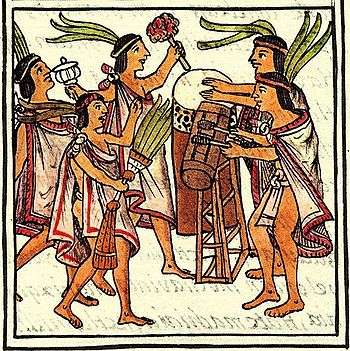Mexica
|
Music and dance during a One Flower ceremony, from the Florentine Codex. | |
| Regions with significant populations | |
|---|---|
| Languages | |
| Nahuatl | |
| Related ethnic groups | |
| Other Nahua peoples |
The Mexica (Nahuatl: Mēxihcah, [meːˈʃiʔkaʔ];[1] the singular is Mēxihcatl [meːˈʃiʔkat͡ɬ][1]) or Mexicas were an indigenous people of the Valley of Mexico, known today as the rulers of the Aztec Empire.
The Mexica were a Nahua people who founded their two cities Tenochtitlan and Tlatelolco on raised islets in Lake Texcoco around AD 1300. After the rise of the Aztec Triple Alliance, the Tenochca Mexica (that is, the inhabitants of Tenochtitlan) assumed a senior position over their two allied cities, Texcoco and Tlacopan.
The Mexica are eponymous of the placename Mexico Mēxihco [meːˈʃiʔko].[2] This refers to the interconnected settlements in the valley which became the site of what is now Mexico City, which held natural, geographical, and population advantages as the metropolitan center of the region of the future Mexican state. This area was expanded upon in the wake of the Spanish conquest and administered from the former Aztec capital as New Spain.
Like many of the peoples around them, the Mexica spoke Nahuatl. The form of Nahuatl used in the 16th century, when it began to be written in the alphabet brought by the Spanish, is known as Classical Nahuatl. Nahuatl is still spoken today by over 1.5 million people.

Notes
References
- Andrews, J. Richard (2003). Introduction to Classical Nahuatl (rev. ed.). Norman: University of Oklahoma Press. ISBN 0-8061-3452-6.
